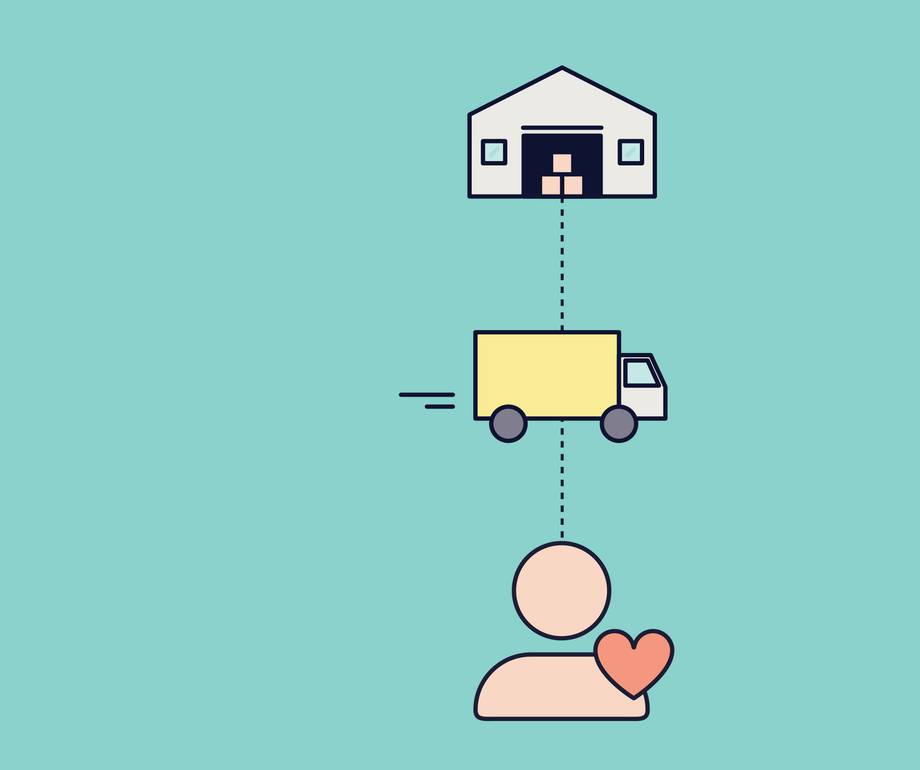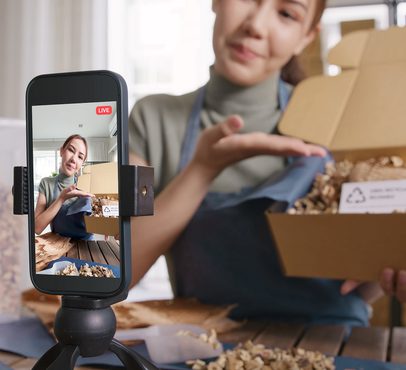But to be successful, it is vital you consider what makes your brand stand out, because it’s crowded out there. Your consumers are seeing a lot of ads and content from your competitors, so how do you make them choose you?
To get your campaigns converting, make that extra effort to ensure your strategy represents your brand well across multiple platforms, building audiences and earning their trust.
Digital marketing tips, tactics and ideas for selling more DTC
Adopt a multi-platform approach. Be sure to now your brand, answer your customers’ questions with your web content and set your stall out using social media. UGC and reviews are of particular importance when selling DTC — and don’t forget to hone your tracking, product structured data, DSA and Google Shopping campaigns.
Know your brand and your audiences well
Before we get to converting and the content you use to do that - people have to know, trust, like or at least be curious about your brand. How are you making sure that happens? A good brand consists of several elements (well, many actually). This includes how you look, sound, how you behave and what you offer.
Now that tracking and targeting consumers is more challenging (thanks to new privacy rules), this is increasingly important.
When you’re creating campaigns, you should be referring back to your values; the vision on which you built your brand to begin with. Couple this with an awareness of your audience and any current challenges, pain points or barriers to converting them.
Your job in this scenario is to further enhance trust in your brand, so when the chips are down, it’s you that those consumers come back to. Based on the idea that 95% of your consumers are not ready to buy now, you need to be consistent and memorable for when they are.
Make the most of your founders or experts
If you’re a small business or have built your brand on your people being visible, then harness the ‘founder’ style of content, with your key faces selling and telling for you via video content. This can help garner loyalty, enhance a sense of connection, which all good brands have with their audiences through one route or another.
Be present, be relevant - map searcher intent to the buying journey
Part of understanding your audiences is knowing the kinds of searches and questions your customers may be asking at each point. Search intent changes through the buying process as users move from seeking a solution to searching for product reviews, and conducting product comparison searches.
You should aim to be as visible as possible throughout the entire process by ensuring that you have the right content in place to answer whatever questions the user may have as they continue their journey to purchase.
Set up shop on social
It’s important to capitalise on all the tools at your disposal. Each platform has its own ways of supporting your sales goals, but social media is revolutionising the way we shop.
Get started by ensuring you have set up your social shops on Instagram, TikTok and Facebook. This allows users to discover your products, browse and even buy without leaving the platform.
Make the most of your ads by tagging products in your content where possible. Use shop catalogues in platforms like Meta to run dynamic ads - these will use machine learning to show customers products Meta thinks they’ll like, as well as show them items they’ve already viewed on your website (as long as they’ve opted into tracking).
As simple as it sounds, use the information at your disposal; make sure to include key info in your sales-driving ads, such as free delivery, free returns, payment options like Klarna and Clearpay and any available discounts that may be applied.
These might be the thing that takes a ‘maybe’ to a ‘yes’ - especially given the current cost of living crisis. Demonstrating you understand what challenges your consumers are facing is a huge part of retaining that trust.
Maximising your TikTok shop
No, it’s not just an app for dancing. Despite TikTok being the relative newcomer to shopping feeds, DTC brands should consider whether they’re making the most of it.
On TikTok, you need 1,000 followers before you can add a shop, so concentrate on following relevant accounts, engaging with hashtags and considering your consumers when creating content. This will help drive those numbers up.
Work with Creators on TikTok to run a collaborative Live TikTok shop, or to tag their products in their content.
Create content that focuses on buying. This might include popular trends like ‘I want it, I got it’ to using hooks like ‘TikTok made me buy it’.
Tag products from your shop in your social media ads and content, where possible - whether that’s an Instagram Story, Feed post or on TikTok.
Lead by (and with) examples - proof, UCG and reviews
That’s not all. It’s important to keep trust and confidence high to boost conversions and one of the best ways to do this is to highlight social proof in your ad content, including UGC, customer reviews and testimonials.
There’s no better way to show that what you’re doing works and is great, fun, exciting or necessary than to show other happy shoppers saying so.
Similarly, for this type of audience, unboxing ads and ads that pull out key features and benefits work well.
Spend your budget wisely
It can be tempting to do a bit of everything, but it’s important to remember what matters to your audiences, where they are and how they’ve shopped with you before - don’t spread your budget too thinly!
DTC can be highly competitive, and while it’s great to be on multiple platforms in order to reach your customers, remember there are different touchpoints. If you find one platform is performing better than others, then consider redistributing your budget into ads that contribute to your bottom line.
Tip-top tracking
As hard as it can be now to track effectively, do everything you can to ensure yours is working for you. While it can be extremely hard to track social, especially on mobile devices, make sure you’re doing everything you can to monitor your results. This includes having tracking pixels set up, using UTM tracking in your links, and setting up events in your paid channels to monitor not only sales, but also add to basket (so you can retarget drop off) - this also includes other metrics such as ‘view product’ and newsletter sign ups.
It’s important to remember in this new world of tracking and consent challenges that you need to start looking at results holistically and being more aware of the bigger picture/bottom line. Take the above into consideration and don’t just pull the plug if you feel one channel is not quite delivering as expected. Pulling campaigns quickly and without awareness of how they’re feeding your overall results can be harmful to your bottom line. Paid social is a very important channel for DTC brands, it’s just a little trickier now to track, but with the right tools, expertise and assistance, you can reap all the rewards.
Dynamism and optimisation
There’s a great deal to be said for creating a shopping feed and advertising your products on Google Shopping. Google Shopping campaigns allow retailers to connect with users who are searching for similar products.
Unlike search campaigns, Google Shopping doesn’t use keywords to determine when to display your ads. Instead, it matches your item titles and descriptions with terms that users are searching for.
To give your product ads the best chance for success (and ensure your ads are showing for the most relevant searches), be sure to spend time optimising your product titles and descriptions. You can do this through the use of a supplemental feed, which essentially overrides the product information you may be pulling through directly from your store.
A great way to stay on top of this is to regularly analyse the search terms that generated your product ads, and your search ads; it’s a treasure trove of information that will help you make your next move.
You can also use dynamic search ads as a quick and efficient way to advertise your product catalogue through paid search. Dynamic search ads (DSAs) use the content of your website to determine whether to show an ad to a user searching for a particular product or service. If a user’s query matches a product you have listed on your site, Google Ads will automatically generate an ad to direct the prospective customer to the relevant landing page on your website.
This can save e-commerce marketers (particularly those with a large and ever-changing inventory) a huge amount of time; imagine creating a new search ad group or campaign for every single product on your site!
However, in order for these ads to succeed, you need to ensure that you have well optimised pages and a logical site structure, and there is some fiddly manual work involved in the beginning. This can include determining which URLs to include in each DSA ad group. But, once it’s set up and running, it can save a huge amount of time in the long run.
Utilise structured data to enhance your product pages
By adding structured data to your product pages, you can enhance their appearance in Google’s search results, making them more enticing for users to click by providing additional information about your products such as price, shipping, availability, and user reviews that stand out against the competition.
Link it up - acquire links and drive direct sales from ‘where to buy’ pages
Many brands have ‘where to buy’ pages with an official list of recommended stockists of their products. These pages can contain links back to your site, which can improve your domain authority - an important factor in improving your ability to rank in organic search results - and drive direct sales as users visit your site to purchase.
Let’s sell more, together
These are just some of the ways we’re helping clients boost their visibility in a crowded DTC marketplace.
Still need help finding your voice? Need a little (or a lot) of help standing out? Our team of experts is here to help.
Drop us a message via our contact page, give us a buzz on 01423 396959 or email hello@madebyextreme.com.
Fancy taking your sales to the next level?
Drop us a messagePost by

Extreme's resident Instagram queen, Beth lives and breathes all things social media! After graduating with a degree in Advertising, she explored all aspects of the digital world before firmly finding her feet in the land of social. Day to day, you can find her brainstorming for campaigns, drafting up witty content and strategising to help clients soar on social.
Project
Post by

Lucie is our lead on all paid media activity, overseeing our talented paid media team and managing the strategy and implementation of all paid search campaigns across multiple platforms. Fully Google qualified and working directly at Google prior to joining Extreme, there's not much Lucie doesn't know about PPC!
Project
Post by

Amy joined in 2014 to set up our Content department. She now heads up a growing Brand and Content team, utilising over 13 years’ experience to deliver brand awareness through targeted, multi-channel copy. As well as engaging content for websites and blogs, Amy delivers PR strategies and tone of voice exploration, helping clients to communicate the purpose and values of their brand with maximum impact.
Project
Post by

Since forming Extreme’s social media department back in 2012, our Head of Social Donna and her team’s work has been recognised nationally. With extensive experience spanning mutiple sectors, Donna specialises in social strategy, ideation and paid social advertising.
Project




